



Blog | Retail & CPG
5th September, 2023

Associate Director, Insights & Analytics
Passionate about marketing, decoding consumer behavior & everything data! Brings 16 plus years’ experience in Digital Analytics, helping organizations define & execute their digital analytics roadmap & strategy in alignment with business goals. He has delivered digital analytics & optimization projects for some of the largest digital businesses in the world. Currently he is leading Brillio’s ‘Digital Analytics’ practice out of India.
In the ever-evolving landscape of customer engagement, the importance of data-driven strategies cannot be overstated. As customer expectations continue to rise, here’s your guide to adapt and excel in delivering personalized experiences.
Did you know 97% of marketers witnessed a rise in business outcomes as a result of personalization? 74% of Gen Zers are interested in personalized products compared to 67% Millennials, 61% Gen Xers and 57% Baby Boomers.
(Source: Salesforce).
Retail industry is experiencing disruption with shopping experiences in the Metaverse i.e., a three-dimensional virtual reality that functions similarly to the actual world. And going by the survey results, majority of the Genz & Millennials already expect personalized products in their brand experiences.
While consumer expectations are rising, are the brands ready to deliver a seamless end-to-end personalized experience?
Here I am going to share how brands can leverage data to drive personalized experiences, from awareness to engagement to purchase. We will go through the end-to-end process on how to identify the right time to reach the target audience using data signals, how to build a ‘growth’ audience for your brand, and how to personalize your customer experience from marketing to sales and nurture it till brand advocacy.
Throughout the content, we will use a story as a baseline example to highlight what the user sees at the moment of conversion and go into flashback of what happens behind the scenes at every step of the way. While this story will be told from a customer perspective, I will explain what happens behind the scenes, and shed light on the intricate processes that transform a casual browser into a satisfied customer.
Let’s begin with the story: Let’s imagine this: a mother at home has a small baby in a crib, peacefully sleeping. Finally, the mother has time for herself, and she’s browsing her social feeds, going through some videos. While she’s browsing, she sees an ad for cotton diapers, and she realizes it’s exactly the thing she was looking for. She clicks on the ad, lands on the page, reads the details, reads the reviews, and instantly buys the product. At first glance, it may appear uncomplicated—the mother merely contemplated her needs, and this brand and its product seamlessly surfaced as she perused her Facebook feed. It all looks very simple, the mother was just thinking about what she needed, and this brand and product immediately showed up while she was surfing her Facebook feed. However, as you well guessed, nothing happens on chance, it’s a highly tailored event that the brand started designing months ago.

We often get this feeling that what we see in the ads that pop up are exactly the things we need, then we click and buy. However, we well know there are a lot of marketing processes involved to make it happen. And everything is fueled by data.
Let’s go into flashback & behind the scenes to understand how it all works. How did the brand reach the point where the customer clicks and buys the product?
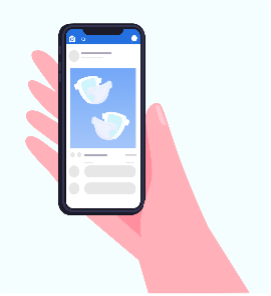
Before launching an ad campaign, any brand that wants to be data-driven needs to thoroughly identify three key elements: The growth audience, The creative & The target audience.
For the company selling cotton diapers, the strategy & marketing team are brainstorming on how to identify the ‘growth’ audience for their brand. They start looking for attributes the product or the brand present, formulate the problem or need they’re trying to solve, and identify what the brand represents.
The customer they’re looking for is the user that resonates with these attributes. In this case, the target audience would be first-time mothers, who are more anxious about the products they’re buying for the baby, probably someone eco-friendly since it’s a cotton diaper, someone who cares about the skin and has the money to buy the product.
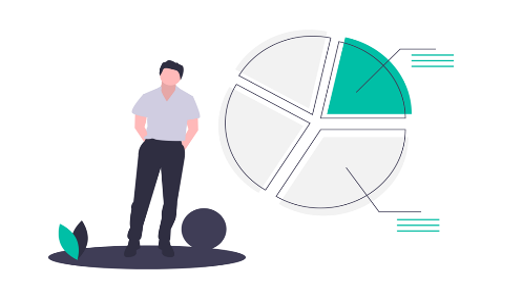
First, they start looking at the existing customer data. What do they already know about their first-party data, their own customers? What are the attributes they can define from that? This will help the company understand who the existing customers are and then start looking at some of the attributes. For example, what’s the purchase frequency, what’s the quantity that they buy?
Data normally gives you trends, patterns, and helps you understand your consumer. Based on data, brands start creating customer personas they can replicate on third-party data sets to find lookalikes. They quantify all those audience segments, to know where they can achieve maxim reach and penetration. Then, they start looking at other data sources. Based on those attributes, we can check other sources of insights.
We look at the creative and ask ourselves how does data fit into this? The creative must resonate with the target audience. Let’s take for example an advertisement for a refrigerator. You could either go for a happy family, everyone eating, sitting on the table, the fridge is packed with food. In this case, you target families, who are spending on delicious homemade food.
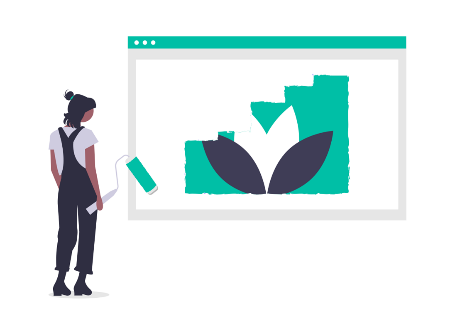
Conversely, an advertisement designed for a distinct audience might depict a refrigerator situated in a workout environment, stocked with health-conscious food choices. This tailored approach would cater specifically to the active demographic, including sports enthusiasts, and similar individuals.
To customize the strategy, engage in collaborative brainstorming sessions with the brand, and create a list of moments where the consumers think about the product in consideration. Once we single out the segments we’re interested in, we create a map of those moments. And then we quantify each of these moments using data i.e., we could use keyword search volume which are related to each of those moments. Subsequent to this rigorous quantification process, we devise creative content meticulously tailored to capitalize on the popular moments by the target audience. The outcome is a strategic approach that significantly enhances the likelihood of achieving a higher click-through rate for the advertisement, thanks to a deep understanding of the audience’s search behavior.
Inching closer to the moment of the cotton diaper purchase, our user – the mother – was reading newborns-related articles, skincare blogs, and shared an Earth Day event on social media.
Behind the scenes, third-party data providers such as Google or Facebook, are tracking these actions. They have probabilistic and deterministic data models, and they would fit this user into multiple segments.
This provides the flexibility for brands to come to Facebook or Google and reach out to these segments.
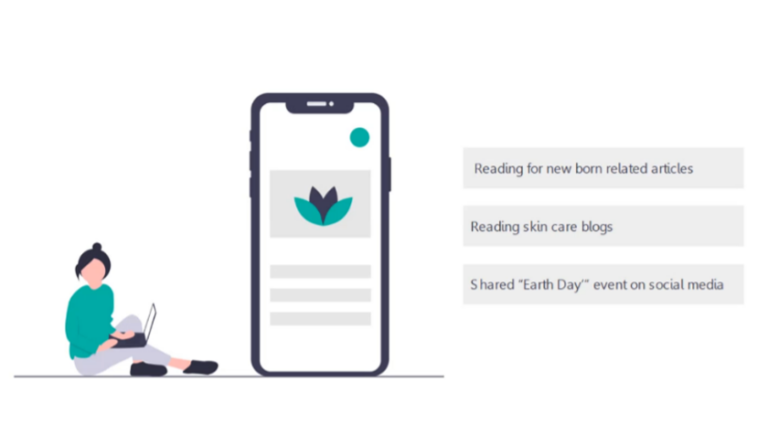
However, there is a slight difference between Facebook Ads and Google Ads. Google serves ads based on searches or the content you’re viewing throughout the Google network. It’s all about the user intent, it’s more of a pull rather than a push. Users already know what they’re searching for, they have already something in their mind. On Facebook, on the other hand, the data is more about user personality, user behavior, user attributes. The ads you would show here are more of a push.
The mother is scrolling, she sees an ad for the diaper. It’s a value pack, it’s about skincare, and it’s eco-friendly, tickling her interests. She believes this is exactly what she wanted, so she clicks on the landing page.
Most of the companies, even if they manage to do this targeting right, they fail at the landing page: 90% of the time it’s a one-size-fits-all type of website. These organizations are missing out on a lot of potential revenue. Companies have all the information required to personalize the landing page so that when someone lands, they already know the user is a valued user. When the user clicks the ad and lands on your website, you already know what the campaign was, who it was targeted towards, and all the attributes the user has. They should personalize the landing page, particularly for that user.
Companies not only have the data about what to show in a particular ad, the content, and the target audience, but also the time to deliver the ad. For example, a brand can find out from clickstream data that the traffic from female segment who is interested in kids’ products, peaks at 10 pm.
There are different personalization and optimization tools, depending on the tech stack.
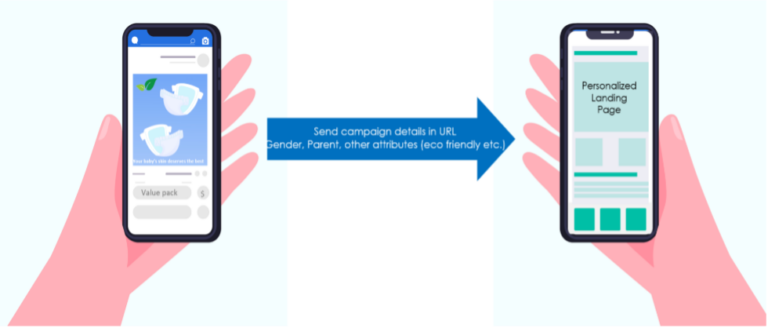
Diverse user personas encounter distinct page variants, strategically employed to optimize customer alignment with the brand. This exemplifies how brands harness data to enhance conversion rates significantly. For users, this marks a pivotal moment of truth when they discern that they possess all the requisite information and proceed with the purchase. The likelihood of conversion to a personalized web page is markedly higher in comparison to standardized, one-size-fits-all websites.
It’s great that the user converted and purchased a product. But what happens next?
The user landed on your website. We know the content and product the user has seen, and we have plenty of data available, which opens another easily accessible revenue stream: retargeting. In our example, after the mother bought diapers, we could send an email or a notification asking if she’s also interested in other baby products, such as baby moisturizers, prompting her to come back to the site.
We can leverage product recommendations based on cookies or CDP segments or we could create a customer scorecard based on all the interactions with the user using clickstream data.
To leverage all this data, we build data models for our clients to decide what the best action should be for a user. Using machine learning models and optimization tools such as Adobe Target or Optimizely, we can further personalize the experience.
Campaign Analysis. Facebook and Google offer brand lift studies designed to augment brand awareness. These concise surveys conveniently surface within the news feed, furnishing insights regarding fluctuations in brand awareness—whether it has risen or diminished. Furthermore, conducting post-campaign analysis allows for an in-depth examination of the campaign’s precise performance.
Conversation Rate Optimization. It involves a comprehensive assessment of various key analyses, including but not limited to landing page analysis, micro-journey analysis, and cross-sell or up-sell analysis. These assessments are facilitated through sophisticated analytical tools like Google Analytics and Adobe Analytics.
A/B Testing Analysis. Since we’re creating personas and showing different creatives, there should be multiple variants of the landing page. We need A/B tests for all the variants to see which experience works best, or if it’s statistically significant or not.
Audience Analysis. If a customer makes purchase, he/she can be uniquely identified in the CDP using email ID, phone no. and other identifier. The CDP also carries insights on overall revenue generated by the customer, customer lifetime value, etc. These metrics help you with deeper insights as you interact more with the customer and continuously improve them.
And that’s how data, analytics and insights help deliver end-to-end personalized experience to customers from the time we show our Ad for the firs time to repeat purchases. It fosters deeper connections between brands and consumers, leading to increased engagement, loyalty, and revenue. Connect with us to tailor experiences for your customers to thrive in the modern marketplace.